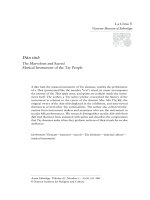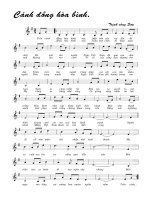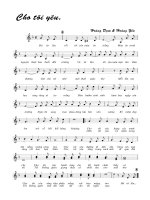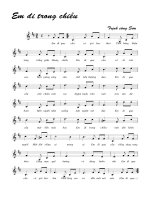Tài liệu MATHLETICS How Gamblers, Managers, and Sports Enthusiasts Use Mathematics in Baseball, Basketball, and Football docx
Bạn đang xem bản rút gọn của tài liệu. Xem và tải ngay bản đầy đủ của tài liệu tại đây (1000.49 KB, 377 trang )
MATHLETICS
This page intentionally left blank
MATHLETICS
How Gamblers, Managers, and Sports Enthusiasts Use
Mathematics in Baseball, Basketball, and Football
WAYNE WINSTON
PRINCETON UNIVERSITY PRESS PRINCETON AND OXFORD
Copyright © 2009 by Princeton University Press
Published by Princeton University Press, 41 William Street,
Princeton, New Jersey 08540
In the United Kingdom: Princeton University Press, 6 Oxford Street,
Woodstock, Oxfordshire OX20 1TW
All Rights Reserved
Library of Congress Cataloging-in-Publication Data
Winston, Wayne L.
Mathletics : how gamblers, managers, and sports enthusiasts use
mathematics in baseball, basketball, and football / Wayne Winston.
p. cm.
Includes bibliographical references and index.
ISBN 978-0-691-13913-5 (hardcover : alk. paper)
1. Sports—Mathematics. I. Title.
GV706.8.W56 2009
796.0151—dc22 2008051678
British Library Cataloging- in- Publication Data is available
This book has been composed in ITC Galliard
Printed on acid- free paper. ∞
press.princeton.edu
Printed in the United States of America
1 3 5 7 9 10 8 6 4 2
To Gregory, Jennifer, and Vivian
This page intentionally left blank
CONTENTS
Preface xi
Ac know ledg ments xiii
List of Abbreviations xv
Part I. Baseball 1
1. Baseball’s Pythagorean Theorem 3
2. Who Had a Better Year, Nomar Garciaparra 11
or Ichiro Suzuki?
The Runs- Created Approach
3. Evaluating Hitters by Linear Weights 17
4. Evaluating Hitters by Monte Carlo Simulation 30
5. Evaluating Baseball Pitchers and Forecasting Future
Pitcher Per for mance 41
6. Baseball Decision- Making 52
7. Evaluating Fielders 64
Sabermetrics’ Last Frontier
8. Player Win Averages 71
9. The Value of Replacement Players 79
Evaluating Trades and Fair Salary
10. Park Factors 84
11. Streakiness in Sports 87
12. The Platoon Effect 102
13. Was Tony Perez a Great Clutch Hitter? 106
14. Pitch Count and Pitcher Effectiveness 110
15. Would Ted Williams Hit .406 Today? 113
16. Was Joe DiMaggio’s 56- Game Hitting Streak the
Greatest Sports Record of All Time? 116
17. Major League Equivalents 123
Part II. Football 125
18. What Makes NFL Teams Win? 127
19. Who’s Better, Tom Brady or Peyton Manning? 132
20. Football States and Values 138
21. Football Decision- Making 101 143
22. A State and Value Analysis of the 2006 Super Bowl 151
Champion Colts
23. If Passing Is Better Than Running, Why Don’t 158
Teams Always Pass?
24. Should We Go for a One- Point or Two- Point Conversion? 165
25. To Give Up the Ball Is Better Than to Receive 172
The Case of College Football Overtime
26. Why Is the NFL’s Overtime System Fatally Flawed? 175
27. How Valuable Are High Draft Picks in the NFL? 180
Part III. Basketball 185
28. Basketball Statistics 101 187
The Four- Factor Model
29. Linear Weights for Evaluating NBA Players 195
30. Adjusted ϩ/ Ϫ Player Ratings 202
31. NBA Lineup Analysis 224
32. Analyzing Team and Individual Matchups 228
33. NBA Players’ Salaries and the Draft 233
34. Are NBA Officials Prejudiced? 237
35. Are College Basketball Games Fixed? 242
36. Did Tim Donaghy Fix NBA Games? 244
37. End- Game Basketball Strategy 248
Part IV. Playing with Money, and
Other Topics for Serious Sports Fans 253
38. Sports Gambling 101 255
39. Freakonomics Meets the Bookmaker 262
40. Rating Sports Teams 266
41. Which League Has Greater Parity, The NFL or the NBA? 283
42. The Ratings Percentage Index (RPI) 287
43. From Point Ratings to Probabilities 290
44. Optimal Money Management 298
The Kelly Growth Criteria
45. Ranking Great Sports Collapses 303
46. Can Money Buy Success? 311
47. Does Joey Crawford Hate the Spurs? 319
viii CONTENTS
48. Does Fatigue Make Cowards of Us All? 321
The Case of NBA Back- to- Back Games and NFL Bye Weeks
49. Can the Bowl Championship Series Be Saved? 324
50. Comparing Players from Different Eras 331
51. Conclusions 335
Index of Databases 341
Annotated Bibliography 343
Index 353
CONTENTS ix
This page intentionally left blank
PREFACE
If you have picked up this book you surely love sports and you probably
like math. You may have read Michael Lewis’s great book Moneyball,
which describes how the Oakland A’s used mathematical analysis to help
them compete successfully with the New York Yankees even though the
average annual payroll for the A’s is less than 40 percent of that of the Yan-
kees. After reading Moneyball, you might have been curious about how
the math models described in the book actually work. You may have heard
how a former night watchman, Bill James, revolutionized the way baseball
professionals evaluate players. You probably want to know exactly how
James and other “sabermetricians” used mathematics to change the way
hitters, pitchers, and fielders are evaluated. You might have heard about
the analysis of Berkeley economic professor David Romer that showed
that NFL teams should rarely punt on fourth down. How did Romer use
mathematics to come up with his controversial conclusion? You might
have heard how Mark Cuban used math models (and his incredible busi-
ness savvy) to revitalize the moribund Dallas Mavericks franchise. What
mathematical models does Cuban use to evaluate NBA players and line-
ups? Maybe you bet once in a while on NFL games and wonder whether
math can help you do better financially. How can math determine the true
probability of a team winning a game, winning the NCAA tournament,
or just covering the point spread? Maybe you think the NBA could have
used math to spot Tim Donaghy’s game fixing before being informed
about it by the FBI. This book will show you how a statistical analysis
would have “red flagged” Donaghy as a potential fixer.
If Moneyball or day- to- day sports viewing has piqued your interest in
how mathematics is used (or can be used) to make decisions in sports and
sports gambling, this book is for you. I hope when you finish reading the
book you will love math almost as much as you love sports.
To date there has been no book that explains how the people running
Major League Baseball, basketball, and football teams and Las Vegas sports
bookies use math. The goal of Mathletics is to demonstrate how simple
arithmetic, probability theory, and statistics can be combined with a large
dose of common sense to better evaluate players and game strategy in
America’s major sports. I will also show how math can be used to rank
sports teams and evaluate sports bets.
Throughout the book you will see references to Excel files (e.g.,
Standings.xls). These files may be downloaded from the book’s Web site,
http:// www.waynewinston.edu).
xii PREFACE
AC KNOW LEDG MENTS
I would like to acknowledge George Nemhauser of Georgia Tech,
Michael Magazine of the University of Cincinnati, and an anonymous re-
viewer for their extremely helpful suggestions. Most of all, I would like to
recognize my best friend and sports handicapper, Jeff Sagarin. My discus-
sions with Jeff about sports and mathematics have always been stimulating,
and this book would not be one- tenth as good if I did not know Jeff.
Thanks to my editor, Vickie Kearn, for her unwavering support through-
out the project. Also thanks to my outstanding production editor, Debbie
Tegarden. Thanks to Jenn Backer for her great copyediting of the manu-
script. Finally, a special thanks to Teresa Reimers of Microsoft Finance for
coming up with the title of the book.
All the math you need to know will be developed as you proceed through
the book. When you have completed the book, you should be capable of do-
ing your own mathletics research using the vast amount of data readily avail-
able on the Internet. Even if your career does not involve sports, I hope
working through the logical analyses described in this book will help you
think more logically and analytically about the decisions you make in your
own career. I also hope you will watch sporting events with a more analytical
perspective. If you enjoy reading this book as much as I enjoyed writing it,
you will have a great time. My contact information is given below. I look for-
ward to hearing from you.
Wayne Winston
Kelley School of Business
Bloomington, Indiana
This page intentionally left blank
ABBREVIATIONS
2B Double
3B Triple
AB At Bats
BA Batting Average
BABIP Batting Average on Balls in Play
BB Bases on Balls (Walks)
BCS Bowl Championship Series
BFP Batters Faced by Pitchers
CS Caught Stealing
D Down
DICE Defense- Independent Component ERA
DIPS Defense- Independent Pitching Statistics
DPAR Defense Adjusted Points above
Replacement
DPY/A Defense- Passing Yards Per Attempt
DRP Defensive Rebounding Percentage
DRY/A Defense Rushing Yards Per Attempt
DTO Defensive Turnover
DTPP Defensive Turnovers Caused Per Possession
DVOA Defense Adjusted Value over Average
EFG Effective Field Goal Percentage
ERA Earned Run Average
EXTRAFG Extra Field Goal
FP Fielding Percentage
FG Field Goal
FT Free Throw
FTR Free Throw Rate
GIDP Ground into Double Play
GO Ground Out
HBP Hit by Pitch
HR Home Run
IP Innings Pitched
K Strikeout
MAD Mean Absolute Deviation
MLB Major League Baseball
OBP On- Base Percentage
OEFG Opponent’s Effective Field Goal Percentage
OFTR Opponent’s Free Throw Rate
ORP Offensive Rebounding Percentage
OPS On- Base Plus Slugging
PAP Pitcher Abuse Points
PENDIF Penalty Differential
PER Player Efficiency Rating
PO Put Out
PORP Points over Replacement Player
PRESSURE TD Pressure Touchdown
PY/A Passing Yards Per Attempt
QB Quarterback
RET TD Return Touchdown
RF Range Factor
RPI Ratings Percentage Index
RSQ R-Squared Value
RY/A Rushing Yards Per Attempt
SAC Sacrifice Bunt
SAFE Spatial Aggregate Fielding Evaluation
SAGWINPOINTS Number of total points earned by player during
a season based on how his game events change
his team’s probability of winning a game (events
that generate a single win will add to a net of
+2000 points)
SAGWINDIFF Sagarin Winning Probability Difference
SB Stolen Base
SF Sacrifice Fly
SLG Slugging Percentage
SS Shortstop
TB Total Bases
TD Touchdown
TO Turnover
TPP Turnovers Committed Per Possession
TPZSG Two- Person Zero Sum Game
xvi ABBREVIATIONS
VORPP Value of a Replacement Player Points
WINDIFF Winning Probability Difference
WINVAL Winning Value
WOBA Weighted On- Base Average
WWRT Wald- Wolfowitz Runs Test
YL Yard Line (where the ball is spotted at start
of a play)
YTG Yards to Go (for a first down)
ABBREVIATIONS xvii
This page intentionally left blank
PART I
BASEBALL
This page intentionally left blank
1
BASEBALL’S PYTHAGOREAN THEOREM
The more runs a baseball team scores, the more games the team should
win. Conversely, the fewer runs a team gives up, the more games the team
should win. Bill James, probably the most celebrated advocate of applying
mathematics to analysis of Major League Baseball (often called sabermet-
rics), studied many years of Major League Baseball (MLB) standings and
found that the percentage of games won by a baseball team can be well ap-
proximated by the formula
(1)
This formula has several desirable properties.
• The predicted win percentage is always between 0 and 1.
• An increase in runs scored increases predicted win percentage.
• A decrease in runs allowed increases predicted win percentage.
Consider a right triangle with a hypotenuse (the longest side) of length
c and two other sides of lengths a and b. Recall from high school geometry
that the Pythagorean Theorem states that a triangle is a right triangle if and
only if a
2
ϩ b
2
ϭ c
2
. For example, a triangle with sides of lengths 3, 4, and
5 is a right triangle because 3
2
ϩ 4
2
ϭ 5
2
. The fact that equation (1) adds up
the squares of two numbers led Bill James to call the relationship described
in (1) Baseball’s Pythagorean Theorem.
Let’s define as a team’s scoring ratio. If we divide
the numerator and denominator of (1) by (runs allowed)
2
, then the value
of the fraction remains unchanged and we may rewrite (1) as equation (1)Ј.
R
runs scored
runs allowed
ϭ
runs scored
runs scored runs allowed
estimate of percentage
of games won.
2
22
ϩ
ϭ
(1)Ј
Figure 1.1 shows how well (1)Ј predicts MLB teams’ winning percentages
for the 1980–2006 seasons.
For example, the 2006 Detroit Tigers (DET) scored 822 runs and gave up
675 runs. Their scoring ratio was Their predicted win
percentage from Baseball’s Pythagorean Theorem was
The 2006 Tigers actually won a fraction of their games, or
Thus (1)Ј was off by 1.1% in predicting the percentage of games won by
the Tigers in 2006.
For each team define error in winning percentage prediction as actual
winning percentage minus predicted winning percentage. For example, for
the 2006 Arizona Diamondbacks (ARI), error ϭ .469Ϫ.490 ϭϪ.021 and
for the 2006 Boston Red Sox (BOS), error ϭ .531Ϫ.497ϭ .034. A positive
95
162
586ϭ
1 218
1 218 1
597
2
2
.
(. )
ϩ
ϭ
R
R
estimate of percentage of games won.
2
2
1ϩ
ϭ
R ϭϭ
822
675
1 218
4 CHAPTER 1
5
6
7
8
11
12
3
4
9
10
CDAB EF I JHG
Year Team Wins Losses
Runs
scored
Runs
allowed
Scoring
ratio
Predicted
winning %
Actual
Winning %
Absolute
Error
1
2
White Sox
868 0.011
Cubs
716 0.017
Reds
749 0.027
Indians
Diamondbacks
Braves
Orioles
Red Sox
Tigers
Marlins
Astros
Royals
870
773
849
768
820
0.072
0.021
0.039
0.010
0.034
Rockies
813
822
758
735
757
0.031
14
15
16
17
20
21
13
18
19
2006
766 1.046
2006
820 1.092
2006
730 0.876
2006
801 1.173
2006
2006
2006
2006
2006
2006
2006
2006
2006
2006
2006
2006
2006
2006
89
88
75
96
97
90
66
80
78
76
79
70
86
95
78
82
62
76
73
74
87
66
65
72
96
82
84
86
83
92
76
67
84
80
100
86
Angels
Dodgers
Brewers
Twins
Yankees
930
1.213
1.218
0.982
1.022
0.780
1.093
0.859
0.935
1.113
0.981
1.055
0.854
0.994
1.001
0.523
0.544
0.434
0.579
0.595
0.597
0.491
0.511
0.378
0.556
0.407
0.494
0.481
0.469
0.488
0.432
0.531
0.469
0.549
0.543
0.463
0.593
0.599
0.586
0.481
0.506
0.383
0.544
0.424
0.466
0.553
0.490
0.527
0.422
0.497
0.501
0.027
0.001
0.029
0.014
0.004
0.011
0.009
0.005
0.005
MAD = 0.020
794
834
801
782
788
805
899
825
812
675
772
719
971
732
751
833
683
767
Figure 1.1. Baseball’s Pythagorean Theorem, 1980Ϫ2006. See file Standings.xls.
error means that the team won more games than predicted while a negative
error means the team won fewer games than predicted. Column J in figure
1.1 computes the absolute value of the prediction error for each team.
Recall that the absolute value of a number is simply the distance of the
number from 0. That is, Խ5Խϭ ԽϪ5Խϭ5. The absolute prediction errors
for each team were averaged to obtain a mea sure of how well the pre-
dicted win percentages fit the actual team winning percentages. The aver-
age of absolute forecasting errors is called the MAD (Mean Absolute
Deviation).
1
For this data set, the predicted winning percentages of the
Pythagorean Theorem were off by an average of 2% per team (cell J1).
Instead of blindly assuming winning percentage can be approximated
by using the square of the scoring ratio, perhaps we should try a formula to
predict winning percentage, such as
(2)
If we vary exp (exponent) in (2) we can make (2) better fit the actual de-
pendence of winning percentage on scoring ratio for different sports. For
baseball, we will allow exp in (2) to vary between 1 and 3. Of course,
exp ϭ 2 reduces to the Pythagorean Theorem.
Figure 1.2 shows how MAD changes as we vary exp between 1 and 3.
2
We
see that indeed exp ϭ 1.9 yields the smallest MAD (1.96%). An exp value of
2 is almost as good (MAD of 1.97%), so for simplicity we will stick with Bill
James’s view that expϭ 2. Therefore, exp ϭ 2 (or 1.9) yields the best fore-
casts if we use an equation of form (2). Of course, there might be another
equation that predicts winning percentage better than the Pythagorean The-
orem from runs scored and allowed. The Pythagorean Theorem is simple
and intuitive, however, and works very well. After all, we are off in predict-
ing team wins by an average of 162 ϫ.02, which is approximately three wins
per team. Therefore, I see no reason to look for a more complicated (albeit
slightly more accurate) model.
R
R
exp
exp
ϩ1
.
BASEBALL’S PYTHAGOREAN THEOREM 5
1
The actual errors were not simply averaged because averaging positive and negative errors
would result in positive and negative errors canceling out. For example, if one team wins 5%
more games than (1)Ј predicts and another team wins 5% fewer games than (1)Ј predicts, the
average of the errors is 0 but the average of the absolute errors is 5%. Of course, in this sim-
ple situation estimating the average error as 5% is correct while estimating the average error as
0% is nonsensical.
2
See the chapter appendix for an explanation of how Excel’s great Data Table feature was
used to determine how MAD changes as exp varied between 1 and 3.
How Well Does the Pythagorean
Theorem Forecast?
To test the utility of the Pythagorean Theorem (or any prediction
model), we should check how well it forecasts the future. I compared the
Pythagorean Theorem’s forecast for each MLB playoff series (1980–
2007) against a prediction based just on games won. For each playoff se-
ries the Pythagorean method would predict the winner to be the team with
the higher scoring ratio, while the “games won” approach simply predicts
the winner of a playoff series to be the team that won more games. We
found that the Pythagorean approach correctly predicted 57 of 106 play-
off series (53.8%) while the “games won” approach correctly predicted the
winner of only 50% (50 out of 100) of playoff series.
3
The reader is prob-
6 CHAPTER 1
5
6
7
8
11
12
4
3
2
9
10
NO
Exp
Variation of MAD as Exp changes
MAD
0.0259
0.0243
0.0228
0.0216
0.0197
0.0318
0.0297
0.0277
0.0200
0.0196
0.0197
0.0200
0.0206
14
15
16
17
20
21
13
18
19
24
25
26
27
22
23
2.3
2.4
2.5
2.6
2.7
2.8
2.9
3.0
1.4
1.5
1.6
1.7
1.0
1.1
1.2
1.3
1.9
2.0
2.1
2.2
1.8
0.0207
0.0216
0.0228
0.0243
0.0260
0.0278
0.0298
0.0318
0.0339
EXP
2
Figure 1.2. Dependence of Pythagorean Theorem accuracy on
exponent. See file Standings.xls.
3
In six playoff series the opposing teams had identical win- loss rec ords so the “Games Won”
approach could not make a prediction.









